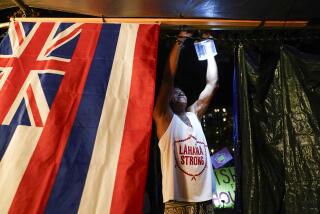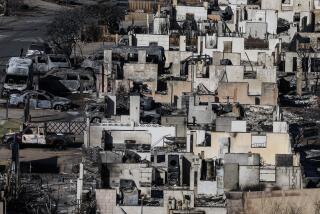U.S. Investors Hop on Hawaiian Resort Bargains as Japanese Retreat
- Share via
HONOLULU — American investors are jockeying to scoop up prestigious resorts in Hawaii at bargain-basement prices as banks pressure their debt-ridden Japanese owners to sell them.
“The bank reforms that went into effect in Japan in April have really forced the issue,” said Joseph Toy, director of real estate and hospitality consulting for Coopers & Lybrand in Honolulu.
“There’s long been talk about the [Japanese] Ministry of Finance being more adamant about divestiture of these troubled loans. But now the pressure is really on,” Toy said.
Japanese banks are under ministry orders to clean up their balance sheets and get rid of bad debts. That means unloading--often at hefty discounts--resorts and other commercial properties built or bought at inflated prices in Hawaii during the Japanese investment “bubble” of the late 1980s.
At the same time, U.S. financial players are flush with cash in a booming national economy. Real estate investment trusts, pension funds and others have capital aplenty looking for a home. Put the two together and they add up to big action in Hawaii’s commercial real estate market.
“The timing is perfect, in the sense that the bargains have begun to run dry on the mainland,” said Paul Brewbaker, chief economist for Bank of Hawaii. “Hawaii deals look quite competitive.”
While the rest of the nation is basking in prosperity, Hawaii’s seven-year economic slump has pushed prices down to the point where they are attracting attention. Starting in 1991, the Aloha State took successive hits from the Persian Gulf War, Hurricane Iniki and the West Coast recession.
All those events cut into tourism, which accounts for nearly one in three jobs in the islands. Hawaii has been mostly left out of the U.S. economic rebound in the last few years, partly because of the drag from Japan’s ailing economy.
Resort and other commercial properties have been changing hands for a fraction of their construction cost or sales prices during the Japanese investment boom, which gave way in 1990.
“The last place where there are still deals to be had in terms of huge discounts is Hawaii,” Toy said. “I’m getting calls constantly. I fully expect that in 1998 we are going to see some major transactions. Anything that was purchased or developed in the mid- to late 1980s is a good candidate for sale.”
The latest property to go on the block is the 720-room Maui Marriott, an oceanfront resort on the Kaanapali coast that averaged more than 80% occupancy last year. The sale is part of a foreclosure suit brought by Mitsui Trust & Banking Co. of Japan against Azabu Building Co., which bought the Marriott in 1986 for a reported $150 million. Azabu also recently walked away from its Keauhou Beach Hotel on the Big Island, letting it revert to the landowner.
Also on the market is a 3,000-acre parcel of land on the Kohala Coast of the Big Island, across from Mauna Lani Resort, that is already approved for development of golf courses and 2,600 homes. Nansay Hawaii Inc., a subsidiary of Tokyo-based Nansay Corp., is asking $10 million for the property, less than a quarter of what it sold for in 1990.
“It will be sold at whatever the market bears,” said Richard Mandel, president of the commercial brokerage division of Kennedy-Wilson International, which is handling the property.
The low prices are relative to the exorbitant sums paid by Japanese buyers during the speculative boom. Developers at that time also spared no expense in constructing palatial resort properties.
For example, developers of the Hyatt Regency Waikoloa installed both an electric tram system and canal waterways to shuttle guests around the 62-acre property.
The sale in 1993 of that 1,200-room Hyatt started the discount-sales trend. The sprawling Big Island resort, developed at a cost of $350 million, was sold for $55 million to an investor group headed by Colony Capital Inc. of Los Angeles.
The next year, the Westin Kauai, developed at a cost of $281 million, was bought by Marriott for $51 million.
Then came the Ritz-Carlton Mauna Lani, the Ritz-Carlton Kapalua, the Kapalua Bay Hotel & Villas and, most recently, the Embassy Suites Kaanapali, all of which sold at huge discounts from their previous cost.
“And there’s more to come,” says Robert Hastings, president of Hastings, Conboy, Braig & Associates, an appraisal and consulting firm in Honolulu. “As far as hotels are concerned, we’re probably one-third of the way through the disposition.”
Although not on the market, other prominent resorts could eventually join the parade. They include the opulent Grand Wailea Resort and the Kea Lani on Maui, as well as the Hapuna Prince Hotel on the Big Island.
Buyers are demanding lower prices these days because Hawaii’s sluggish economy puts investors at greater risk.
*
Appraisers generally calculate that a hotel room is worth roughly 1,000 times its daily room rate. During the Japanese buying spree in the late ‘80s, valuations shot up to 2,000 times the room rate, Hastings said. Recently, he said, valuations have dropped to about 800 times the room rate.
Many Japanese investors have been reluctant to face up to the extent of their troubles in Hawaii, which began when the flow of low-cost funds was cut off in Tokyo in the early 1990s, about the same time the islands’ tourism industry took a dive. Some investors dodged the bullet by finding other borrowers to assume financial liability. Others hung on, despite crushing debt burdens, in hopes of saving face or seeing things turn around.
“Japanese investors like Hawaii and have been slower to clean up those loans and properties,” Mandel said. “Many have tried to hold on to their Hawaiian assets versus other properties in the United States because of their affinity for the islands. But the weakness in the economy in Japan is forcing them to sell even these treasured assets.”
The “big bang” opening of Japan’s financial system includes reforms that are pushing Japanese banks to bring their capital-to-assets ratios up to international standards.
“They’ve been hiding the problem,” Hastings said. “But now the regulators have caught up with them and told them, ‘You’ve got to get these properties sold.’ That’s why we’ve had this flurry of activity.”
Because the troubled loans are held offshore, the losses are not absorbed in Hawaii, and the transfer of ownership should be healthy for Hawaii’s struggling economy. By buying at low prices, the new owners can pump in money to renovate and reorient the properties to catch current trends in the hospitality industry.
“The acquisition in a sense liberates the property, frees it up from the indebtedness,” Bank of Hawaii’s Brewbaker said. “These transactions will help reposition Hawaii’s capital stock more competitively in the global marketplace.”
A similar trend is evident in other commercial real estate projects in the islands. As the office market cycle here bottoms out, it is attracting investor and capital market funds.
Trinity Investment Trust recently acquired the mortgage on the Aloha Tower Marketplace, a retail-restaurant complex on the Honolulu waterfront, at a substantial discount. In 1996, Trinity also bought Harbor Court, a commercial high-rise nearby, for less than half its construction cost.
*
Retail development has shifted into high gear in spite of Asia’s financial setbacks. Eighteen new shopping centers have been proposed around Hawaii, according to Stephany Sofos, commercial real estate consultant and president of SL Sofos & Co. If built, she said, they would boost the current gross leasable area from 20 million square feet to 27 million.
“Mainland investors--Forrest City, Simon DeBartolo, the Mills Corp.--they’re all looking at doing projects in Hawaii,” she said. “They’re intrigued and excited by the sales per square foot, which average about 35% higher than the U.S. nationally. There’s a race on.”
Hawaii’s commercial real estate market has been on a roller-coaster ride in the last decade. What has changed now is who is in the driver’s seat.
“It’s an interesting role reversal,” says Joseph Toy. “The U.S. investors are coming in now, buying these properties at huge discounts, far below replacement costs, while the Japanese are sitting out this investment boom.”
(BEGIN TEXT OF INFOBOX / INFOGRAPHIC)
Hotel Investment in Hawaii
*--*
Construction cost or sales Recent price, 1986-90, sale price, Date Hotel in millions in millions of sale Discount Embassy Suites Kaanapali $174 $68.0 1997 61% Kauai Resort Hotel* 27 3.8 1997 86 Waikiki Terrace 52 22.5 1997 57 Kapalua Bay Hotel 104 19.0 1996 82 Ritz-Carlton Kapalua 176 100.0 1996 43 Alana Waikiki 80 38.0 1995 53 Ritz-Carlton Mauna Lani 186 76.0 1995 59 Westin Kauai 281 51.0 1994 82 Hyatt Regency Waikoloa 350 55.0 1993 84
*--*
More to Read
Inside the business of entertainment
The Wide Shot brings you news, analysis and insights on everything from streaming wars to production — and what it all means for the future.
You may occasionally receive promotional content from the Los Angeles Times.










